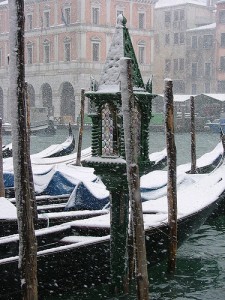Anno del Ghiaccio – Venice in Winter
Like most I suspect, when I think of Venice I imagine a sun-baked Piazza of San Marco, but of course winter visits Venice each year and it seems that before the advent of modern heating, the experience was particularly brutal. In his engaging journals recounting his three years in Venice during the 1860s, W.D. Powell describes the attitude of the locals to winter:
“The Venetians pretend that many of the late winters have been much severer than those of former years, but I think this pretense has less support in fact than in the custom of mankind everywhere to claim that such weather as the present, whatever it happens to be, was never seen before.”
In common with other places (like California) where the weather is generally agreeable, houses are built with a view to coolness in summer and one can only imagine that the experience of a Christmas or Epiphany feast in the spacious interior of San Marco was often a chilly one. In fact in Howell’s judgment it is those who must spend their time indoors that suffer the most.
“When one goes out into the sun, one often finds an overcoat too heavy, but it never gives warmth enough in the house, where the Venetian sometimes wears it. Ineed the sun is recognized by Venetians as the only legitimate source of heat, and they sell his favor at fabulous prices to such foreigners as take the lodgings into which he shines.”
Howell also notes the local celebration of the “Anno del Ghiaccio” (Year of Ice) that commemorated a memorably cold winter early at the turn of the 18th century that coincided (fittingly) with a visit of the King of Denmark. (The winter of 2004-2005 was also memorably snowy in Venice and an album of photos can be viewed here.) The lagoon was frozen solid for over two weeks and became “a scene of the liveliest traffic, and was everywhere covered with sledges…Venetians of every class amused themselves in visiting this free mart.”
He goes to describe the Piazza and Basilica most beautifully.
“The lofty crest of the bell tower was hidden in the folds of falling snow, and I could no longer see the golden angel upon its summit. But looked at across the Piazza, the beautiful outline of St. Mark’s Church was perfectly penciled in the air, and the shifting threads of the snow-fall were woven into a spell of novel enchatment around a structure that always seemed to me too exquisite in its fantastic loveliness to be anything but the creation of magic.”
Magic indeed.
